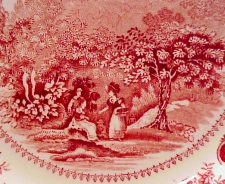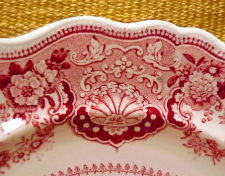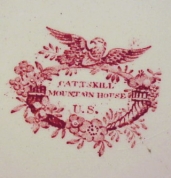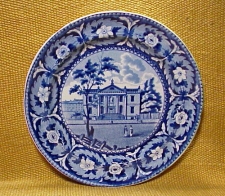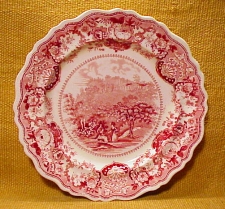Posted By: Mark
Posted on: 2012-11-18 09:12:00
Featured Item: Eighteenth Century Worcester
Soft Paste Porcelain Dessert Plate
"Blind Earl" Pattern
Antiques dealers – and I suppose all people in business -- live and die by the cues the public gives them. For Seekers Antiques, from the very beginning, some of those cues came in the form of the buzzwords we repeatedly heard, sometimes overheard, sometimes had hurled at us like a challenge. Such words as Rookwood Scenic, Queen’s Burmese, Dr.Wall , “Old Imari” and Masons “Green Mandarin” have intermingled over the years with more general terms like American Historical, Leeds Feather Edge, “Canary” (see our earlier piece on Adam Buck) and Soft Paste Porcelain. We have heard these terms and pursued them --with varying degrees of success. We have also discovered that these terms sometimes merely provided currency for a portion of the public who simply wanted to appear “smart.” Still, as professional dealers, we have looked upon it as our job to delve into each of the areas associated with these terms. In return, each area has given us some measure of satisfaction for the experience.
One of those areas wrapped in a seemingly impenetrable cloud of misunderstanding is English Soft Paste Porcelain. While the term is fairly common among collecting circles, usage quickly separates the “smart” set from the intelligent.
Arriving in the mid eighteenth century, the English came late to the party when it came to porcelain; however the bounty they produced is ravishing. Additionally, the story of porcelain is just as engaging, from its first European appearance in the fourteenth century through the early years of English production in the eighteenth century. The Worcester “Blind Earl” pattern (a term itself holding some currency with the public) is one pattern among a rainbow of English eighteenth century soft paste wares – and so it is that we have chosen Worcester’s “Blind Earl” as an entrée into this intriguing world and as this month’s featured item.
18th Century Worcester Dessert Plate “Blind Earl” Pattern
(Click on dessert plate photo to link to website listing)
Diameter: 7 ½ in.
Dates: Mid 1760’s to 1770
Price: $1750.00
We have divided this article into three parts. First is a general discussion of porcelain, with definitions and history. The second part takes a short look at the development of English porcelain and the Worcester works. Finally we arrive at the “Blind Earl” pattern and our featured object.
Porcelain: A General Discussion
What is porcelain and why do we categorize it as hard or soft?
According to The Oxford Companion to the Decorative Arts, porcelain was developed by the Chinese some time in antiquity. It is a glassy, brilliantly white ceramic ware that can be potted amazingly thin yet remain durable. The Chinese ceramic body is a combination of kaolin (china clay) and petuntse, a feldspathic rock. This combination “vitrifies”-- that is, it takes on glass-like qualities including translucence –when subjected to intense firing conditions.
Porcelain was introduced to Europe around 1300 by Marco Polo in the account of his travels (along with pasta, printing, papermaking and a host of other concepts which we take for granted). According to The Oxford Companion to the Decorative Arts, the name itself is not oriental, but rather Marco Polo’s tag, derived from the Portuguese term for cowrie shells, porcela. Given no western equivalent, the wares seem to have been named based on their remarkable resemblance to the sheen of the shell’s surface.
Porcelain was first seen in Europe as one of the items of choice for state gifts accompanying diplomatic embassies. Even though quantities were small, European response to this beautiful new material was spectacular. Hillary Young in English Porcelain 1745-95 gives us insights into the growing interest in porcelain leading up to the eighteenth century. Given its rarity, porcelain was so treasured that it became a status symbol. Examples mounted in precious metals scattered throughout European treasuries and museums today bear testimony to this high regard. Desire was enhanced early in the seventeenth century by the trickle of wares offered by the Portuguese who had established a trading base near Canton as early as 1515. Later In the seventeenth century, additional European maritime powers established private companies to encourage trade with the Far East, resulting in a slightly greater accessibility to porcelain. This accessibility only fed a growing obsession for porcelain among public and princes, both royal and merchant. As Young notes, the goal for Europeans became the production of wares equivalent to the precious far eastern imports.
From the very beginning, however, everything about porcelain from ingredients to production processes was shrouded in mystery. Hints came from the tales of travelers like Polo who spoke of a thirty or forty year period for the preparation of clay suitable for porcelain. The first challenge was discovery of the ingredients which made up the Chinese wares. Once that was ferreted out, European equivalents had to be devised. It was not until the early eighteenth century that some real clarification emerged, provided, Hillary Young reports, by the letters of a Jesuit missionary, Pere Francois Xavier d’Entrecolles, who had been resident at one of the great ceramic centers of China a few years earlier.
European production emerged for a short time, sponsored by the Medici in Florence in the late sixteenth century and reappeared with greater longevity in France in the late seventeenth. The establishment of the Meissen porcelain works around 1710 was the off-shoot of a monarch’s obsessive pursuit of the alchemist’s mythical secret for turning base metals to gold. The lust for porcelain truly ran parallel to the lust for gold (This sometimes exciting, sometimes appalling story is told in Janet Gleeson’s entertaining 1998 book, The Arcanum—highly recommended). Inevitably, the secret of Meissen’s success could not be kept concealed; the leak led to the permanent establishment of porcelain production at several sites on the continent.
Geoffrey Godden in Godden’s Guide to English Porcelain notes that in the end, two types of porcelain emerged. The first, hard paste, was created from a combination of ingredients similar to the original oriental model and transformed in a single intense firing. The second, artificial or soft paste, achieved an acceptable degree of whiteness and translucence using a variety of improvised, substitute components and multiple firings. This second body was tagged “artificial” because the combined ingredients varied widely from the china clay and feldspar of oriental porcelain and “soft” because the paste could not withstand the intensity necessary for a single firing. (A terminology hint: the word “paste” always refers to a porcelain type body.)
Obviously this usage runs contrary to our intuitive sense. The terms hard paste and soft paste have nothing to do with the durability or hardness of the body, but to the combination of ingredients, processes and firing temperatures necessary for transformation into porcelain.
Features of the soft paste porcelain body include a slightly creamier tinge than hard paste. Experienced collectors always speak of the warmer feel and point out the way enamel decoration appears to almost sink into the surface of the soft paste body. By contrast, enamels tend to stand up against the hard paste body underscoring the sense of its brilliant, gem-like surface. If by chance a soft paste object has been nicked, the body revealed beneath the glaze will appear granular -- like a lump of sugar. The same nick on a hard paste piece will appear faceted like a chip on glass or flint.
All of this said, Godden cautions collectors not to become too enmeshed in the hard vs. soft paste concerns. In our own experience, which Godden confirms, this knowledge, almost instinctual, is acquired more by examining and handling the wares than by any mental gymnastics.
Godden also tells us that most eighteenth century English porcelain is of the soft paste variety.
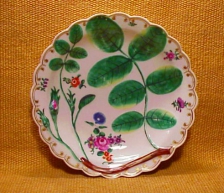 English Soft Paste and Worcester
English Soft Paste and Worcester
The development of porcelain production on the European continent was the result of sponsorship by royal patrons who had been caught up in porcelain fever. Naturally these efforts were fraught with the intrigue that accompanies state patronage and politics. English porcelain developed in quite a different context and faced a different set of challenges. The development of English porcelain coincided with the industrial revolution, and its pioneers rose and fell as entrepreneurs.
The British lagged behind continental porcelain producers. While English patents relating to porcelain making were issued as early as 1671, it was not until 1742 that the first patent relevant to the evolving English porcelain industry appeared. Shortly after that, around 1744-45, the first marketable, home-grown English porcelain followed with the establishment of the Chelsea works. At this point, however, entrepreneurial spirit kicked in and the next few years witnessed a whirlwind of trial and error. New ventures sprang up seemingly overnight, and often disappeared just as quickly. Hillary Young notes the establishment of at least thirteen commercially viable concerns between the mid 1740’s and about 1757. Young also notes that one could probably double that number based on all the porcelain works recorded in the period whose product we have yet to identify. While a general process for producing porcelain was relatively common knowledge, the paste formulas and processes were as varied as the potters themselves, and not surprisingly everything was shrouded in secrecy.
The majority of these ventures survived three to ten years, providing a tangle of products challenging collectors to this day. In fact, only two of these early ventures, Derby and Worcester, survived into the nineteenth century (and they survived through most of the twentieth.) On top of this, while a pottery might fail, the potters did not vanish and their technical experience and methodology often served them in new ventures – again adding to the attribution muddle.
In The Dictionary of Worcester Porcelain, John Sandon cites an early nineteenth century source which claims that the earliest porcelain created at Worcester was achieved in a cauldron banked in the fire of a Worcester apothecary’s hearth. Two men were engaged in this experiment, the apothecary William Davis and Dr. John Wall, whose name has commonly come to designate the first period of Worcester’s production. They leveraged their discovery into a manufacturing concern with thirteen other investors according to the partnership agreement drawn up on June 4, 1751 and preserved today in the Dyson Perrins Museum, Worcester. Debate has ensued over what role Davis and Wall actually played, however John Sandon points to archaeological finds on the factory site which lend credence to the Wall and Davis tradition.
However Sandon goes on to point out that if these same shards are any indication of Worcester’s capabilities at the time, the decision most responsible for Worcester’s early success was the acquisition of the nearby Bristol porcelain works. Through this transaction the Worcester partners acquired Bristol’s process, mining rights to a principal ingredient, soaprock, and the services of one of the partners, Benjamin Lund.
According to Sandon, Benjamin Lund was one of those potters who just kept popping up in the churning waters of the eighteenth century English porcelain business. He started as a partner in an early London pottery, Limehouse (1746 to 1748). Building on his Limehouse experience, Lund continued developing his porcelain body in Bristol (1749 to 1752). In February of 1752, as the Bristol venture moved toward bankruptcy, the Worcester partners took action, absorbing the total venture. Lund’s expertise with blue decoration and his white body proved a cornerstone of early Worcester production, short-circuiting the years of experimental trial and error others had to endure and survive. (To the disadvantage of collectors, however, Worcester’s blue and white wares of this period are often indistinguishable from Lund’s Bristol wares.)
This now takes us to one of Worcester’s early successes – their “Blind Earl” pattern.
_f225x194_1353264308.jpg) Worcester's Blind Earl Pattern
Worcester's Blind Earl Pattern
It is the porcelain blank, rather than the surface decoration that gives the “Blind Earl” pattern its identifying characteristic. Molded into the surface is a floral relief consisting of a large spray of rose leaves and a smaller but more sharply raised rosebud, both elements picked out in colored enamels or cobalt blue highlights. Typically, the flat surface will be sprinkled with flat-painted floral sprigs providing additional accents. Dishes are finished with a delicate gilt border just inside the molded scalloped edge.
The origins of the “Blind Earl” design are obscure at this point. The model seems to have been provided by Chelsea – which generally held the position of tastemaker for the first few years of its existence. In their catalog of the great Zorensky Worcester collection, Simon Spero and John Sandon refer to a listing for similar “desart” (dessert) wares in a Chelsea sale catalog of the mid 1750’s and estimate the appearance of the Worcester pattern at around 1757 or ’58.(1) The dessert dish shape was introduced in the mid 1760’s(2); our example dates between that point and the early 1770’s.
Curiously, Worcester made only three shapes in the “Blind Earl” pattern in the eighteenth century, not a complete dinner service. There is our individual dessert dish, made in one size only. To serve sweetmeats at the tea or dessert table, Worcester provided a smaller circular dish with a single twig-molded handle at one side (illustrated below). As an additional accessory, there was a small elongated oval tray with handles at both ends, designed to hold tea spoons elegantly. A mold for a bowl was found during excavations at the Worcester site, but no finished examples of the form are known.
Why was such a limit imposed on the pattern? In the eighteenth century, china was not considered in terms of “sets.” The pieces available in “Blind Earl” relate to their use as a dessert course or for serving sweets accompanying tea. We like to think this reflects a strategic restraint on the part of the early Worcester china makers. With its unique, but delicate, relief decoration, a few pieces of “Blind Earl” on the table would intrigue diners. An entire banquet table full would risk blunting the effect.
As described earlier the typical “Blind Earl” example is hand decorated in polychrome enamels or cobalt blue highlights.
Variations exist, however, suggesting that the shapes were used as accent pieces in larger services of completely different patterns. In these examples, the contrasting painted or printed pattern runs across the surface in complete disregard of the floral relief below. In effect, these pieces offer two patterns—one for the eyes, one more oriented to the sense of touch.
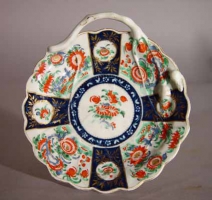
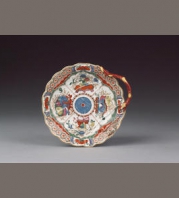
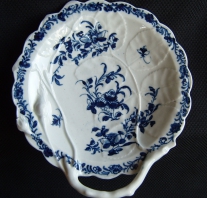
The patterns illustrated are (left to right) “Best Queens,” “Dragon in Compartment,” a blue transfer-printed pattern.
There is one additional decoration variable. “Blind Earl” pieces were decorated both at the Worcester factory and the London atelier of James Giles. The brushwork of Giles pieces generally displays a freer, spontaneous quality. The tight precision of the floral nosegays and the border scrolls of our dish suggests the more meticulous finish of factory decoration.
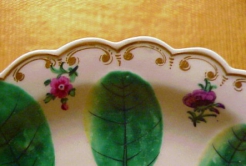
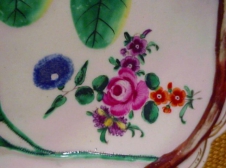
The Blind Earl Legend
So – at long last -- where does the name, “Blind Earl” come from?
Memorable patterns often acquire catchy nicknames. Usually the origin of the moniker is fairly obvious. Spode’s “Leaping Frog” comes from a suggestive squiggle in the oriental motif. The “Royal” part of Worcester’s “Royal Lily” was added after George III and Charlotte visited the pottery and ordered a set. Likewise the “Blind Earl” name derives from noble patronage, but things become a bit murky.
According to legend, the pattern was created for the Earl of Coventry who had lost his sight in a hunting accident. In the absence of sight, the Earl requested Worcester create a service he could feel. Thus was born the beautiful, tactile, classic “Blind Earl” pattern.
How conveniently neat and romantic. Only – as often the case with such stories -- there is disconnect between dates, documented facts, and the elements of the legend. According to Sandon, there was an Earl of Coventry (the seventh) who lost his sight in a hunting accident in 1780 (according to Worcestershire county records). Subsequently his grandson, number nine, was also blinded in a hunting accident, this time in 1834. Sandon sites records at the seat of the Coventry family, Croome Court, which make note of the unlucky sequence. Remember, however, that Worcester introduced the pattern way back in the 1750’s (3) and seem to have been motivated by inspiration from Chelsea, not from a commission, noble or not.
The Dyson Perrins Museum in Worcester neatly skirts the issue stating:
“In the 19th century the pattern was named after the Earl of Coventry who lost his sight in a riding accident. He ordered a service in this pattern so that he could feel the raised decoration.”
Sandon notes that there are pieces extant at Croome Court from a service ordered circa 1815. Since the unfortunate seventh earl died in 1831, it may be this service that gave the pattern its colorful tag. (4)
“Blind Earl” After the Eighteenth Century
The “Blind Earl” pattern continued to be produced by the various Worcester partnerships throughout the nineteenth century and into the twentieth. The later nineteenth century examples were executed in bone china, which more closely approximates hard paste porcelain, than the soft paste antecedents. Also, perceiving the pattern’s popularity, Worcester no longer limited the pattern to the three early shapes. Sandon illustrates a “Blind Earl” service complete with dessert tureens and elaborately shaped dishes dating around 1840. (5)
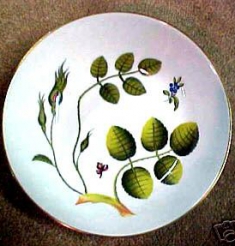
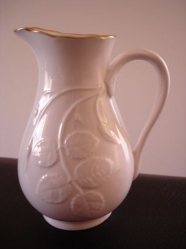
Production of the venerable pattern continued into the twentieth century. It was not, however, kept safe from some fairly radical attempts to modernize the classic. These modern versions range from a printed version with no molded relief and a graphic style reminiscent of 1950’s kitchen wall paper to a white version with relief but no enamel highlighting. Somehow or other, however, the prestige of the pattern remains, as given testimony by the provenance of this lot from one of Messrs. Christies latter day sales.
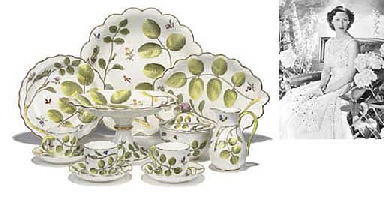
From the estate of HRH Princess Margaret, Countess of Snowden
Later, Mark
Sources
Gleeson, Janet; The Arcanum, The Extraordinary True Story; Warner Books, New York 1998
Young, Hillary; English Porcelain, 1745-1795, Its Makers, Design, Marketing and Consumption; V&A Publications, London 1999
Osborne, Harold (Editor); The Oxford Companion To The Decorative Arts; Oxford University Press, Oxford 1985
Godden, Geoffrey, FRSA; Godden’s Guide to English Porcelain; Wallace-Homestead Book Company, Radnor, Pennsylvania, 1992
Spero, Simon & Sandon, John; Worcester Porcelain, 1751-1790, The Zorensky Collection; Antique Collectors’ Club, Woodbridge, Suffolk, UK, 1996
Sandon, John; The Dictionary of Worcester Porcelain, Volume I, 1751-1851 ; The Antiques Collectors’ Club, Woodbridge, Suffolk, UK, 1993
Footnotes
(1)Spero, Simon & Sandon, John; Worcester Porcelain, 1751-1790, The Zorensky Collection; Cat. No. 87, P. 119
(2)Ibid; Cat. No. 208, P. 193
(3) Sandon, John; The Dictionary of Worcester Porcelain, Volume I, 1751-1851 ; P. 71
(4)Ibid; Color Plate 10, P. 57
(5)Ibid; Color Plate 10, P. 57
Photo Statement
All images of Seekers inventory come from Seekers files. Support images of additional pieces come from Google Images. We will be happy to remove or provide additional attribution on additional images on request.
Posted By: Mark
Posted on: 2012-07-23 10:53:47
Featured Item: Adams "Cattskill Mountain House" Dinner Plate
Once upon a time, around thirty years ago – when Seekers Antique was just starting – our world was filled with wonderful and fascinating things: some rare, some common, some we have never seen again (I’m sure), and some which we dismissed instantly. One sunny spring day as we were shopping an outdoor market, we saw a stack of 1830’s red transfer dinner plates emerge from somebody’s trunk. The scene showcased an impressive structure perched on a distant mountain plateau in romantic woodland scenery. The mark read “Cattskill Mountain House, U.S.” Obviously these were special -- American historical transfer. While they were priced to sell individually, the stack of five identical dinner plates was intriguing. After some debate, we purchased two plates. Still, I found the entire offering fascinating: the historical view, the stack of dinner plates, and of course the subject itself, the Catskill Mountain House. Later, Ellouise Baker Larsen’s work on historical transfer added an additional twist, noting that the scene was derived from the work of Thomas Cole.
So now around thirty years later, this “Featured Item” essay gives me the excuse to sort it all out and indulge my curiosity with a look at this William Adams and Sons “Cattskill Mountain House, U.S.” red transfer dinner plate.
Diameter: 10 1/4 in.
Dates: 1830's
Price: $395.00
Background: The Young Republic
This view of the Catskill Mountain House has its origins in the America of the 1820’s. Approaching our fiftieth birthday, there was a sense of change in the air, the transformation of the country from relative backwardness to the status of a leading commercial power.
A major bellwether of this change was the construction of the Erie Canal. Upon its completion in October 1825, goods produced in the Great Lakes region could be swiftly and economically shipped (at a savings of 95%) to the east coast resulting in exponential increases in commerce – and wealth. As the final seaboard terminus of this trade route, New York City immediately assumed the position of the preeminent U.S. port. Other cities, primarily in the north, scrambled for position resulting in an unprecedented rash of improvements in infrastructure and transportation. The flow of goods and information, once limited to north-south movement along the Atlantic coast or the Mississippi and her tributaries, soon followed manmade routes joining the northeast to the western states and territories.
In spite of the excitement generated by technology, there remained some sense of inferiority which Americans seemed unable to shake off. None of the ancient treasures, art, and architecture by which the world measured societies was to be found in this new land. Despite modeling ourselves on ancient Rome, our government, buildings, decoration, dress, and even language, we still lacked the gravitas of long-established civilization.
Gradually, however, Americans came to appreciate a national resource that defied comparison to the old world, the unencumbered natural grandeur of North America. The American landscape, still unspoiled by the hand of man, underscored America’s special destiny in the world. The results were momentous, spawning the first school of truly American painting, the Hudson River School. A second watershed came in the form of published volumes of American scenery which also generated prints and steel engravings reaching larger and larger portions of the population. Moreover, these images would -- in the hands of enterprising Staffordshire potters –find their way onto tablewares, an everyday reminder for Americans of many stripes of that sacred grandeur which marked America apart from all others.
Finally, on an individual level, great fortunes were being assembled by an emerging class of entrepreneurs. Neither wealthy farmers, nor members of the old colonial aristocracy, these sons and daughters of the original patriots were reaping the financial rewards of all this change. A new sense of affluence not only provided support to the emerging fine arts, but also enabled the growth of a new pastime, landscape tourism.
Landscape Tourism
Landscape Tourism was an English phenomenon which in the closing decades of the eighteenth century offered an antidote for the social and political rumblings which the upper classes found so unsettling. This involved the constant search for and travel to parts of England untouched by modernization. In addition to natural beauty, the traveler sought what was termed “picturesque” -- derelict hovels, mossy banks, dilapidated buildings, moldy barns, shaggy farm animals, motley Gypsies, beggars, ragged farm families, and so forth. As the nineteenth century progressed and the franchise of wealth reached larger portions of the population, this interest in the picturesque remained, providing fodder for the publishing, and by extension ceramics industries.
In America, independence aside, the upper classes still looked to England for cultural models; therefore, it was not difficult for Americans to catch on to this concept of landscape tourism. However, in the United States, this pursuit was elevated to almost spiritual levels as the virgin landscape came to symbolize the noble virtues upon which the country had been founded. While the eastern United States had no mountains comparable to the Alps, nothing could surpass the power and majesty of Niagara, and there was a seemingly endless supply of landscape unencumbered by the presence of man, the goal of these first American tourists.
Thus with this combination of affluence, accessibility to travel, and the knowledge of and desire to experience scenery with the power to inspire, the stage was set for America’s first leisure resort, the Catskill Mountain House.
On September 30, 1822, notice appeared in Poulson’s Daily American Advertiser (of Philadelphia) that “a large number of ladies and gentlemen of the first fashion and respectability, from the counties of Albany, Columbia, Dutchess and Greene” found themselves at a ball “at the Pine Orchard Ridge on the Catskill Mountains,” September 22, 1822. The article went on to describe an archetypal Autumn day – clear and beautiful, the mountain scenery “in the fullness of pride, and unusually imposing.” Mention is made of the opportunity several parties took of arriving early to enjoy the views, “which for extent and variety are not surpassed by those of any country.” Finally the author noted that the site, 2800 feet above the river, afforded a spectacular view of the Hudson River Valley, extending hundreds of miles into Vermont, New Hampshire and Massachusetts. A “temporary” ballroom some sixty feet in length had been erected for the occasion, specially lit and decked out in mountain greenery. Commencing at 7:00 the event went on into the wee hours of the morning, finally ending at 2:00 A.M. The author sums it up as an assembly of “striking beauty and taste.”
However, this was not merely an assembly of society indulging in fashionable pastimes. What was reported in the press was an event conceived by local Catskill businessmen to attract the upper classes of the surrounding locale to drum up investment in a road and excursion hotel on the site. The scheme worked and the Catskill Mountain Association was formed. The following year ground was broken, and the opening of the new hotel followed in the spring of 1824.
The hotel quickly achieved success. An 1826 account from the Boston Recorder and Telegraph records one guest’s impression of the hotel -- “like enchantment.” Reporting less than two years after completion, the article noted that the facility had already been enlarged to handle two or three hundred people with a “noble piazza running the whole length of the front,” all maintained in elegant style.
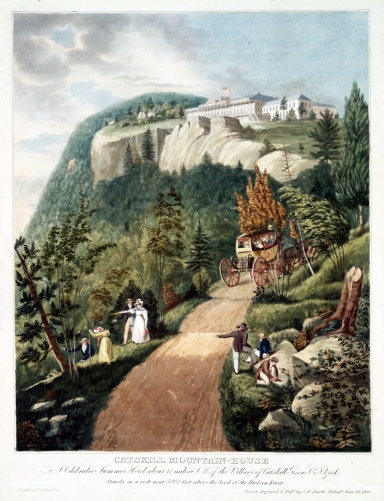
John Rubens Smith, Catskill Mountain-House: A Celebrated Summer Hotel.... Aquatint , 1830. Museum of Fine Arts, Boston.
By the end of its first decade, the Catskill Mountain House had secured its reputation. By mid century, the hotel had become the premiere watering hole for America’s elite. In time the hotel would host three American presidents, Ulysses S. Grant, Chester A. Arthur and Theodore Roosevelt. The hotel also attracted a literary following including Washington Irving and his circle. The writings –geological, historical, or romanticized -- of Irving, Bryant, Cooper and others encouraged the public’s infatuation with the Hudson River region. They were joined by artists. It was natural that members of the Hudson River group would develop a fondness for the Catskill Mountain House given the spectacular panorama it offered and the opportunities represented by the its well-heeled clientele. The hotel was repeatedly pictured in their views. One artist in particular, however, has to be singled out, founder of the Hudson River landscape tradition, Thomas Cole.
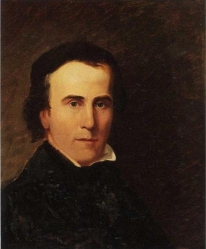
Thomas Cole, Self-Portrait, 1836. Collection of the New York Historical Society.
Thomas Cole and the "Cattskill Mountain House, U.S."
In late August or early September of 1825,not long after the opening of the Catskill Mountain House, Thomas Cole set out from New York City on a sketching tour of the Hudson Highlands and Catskills. He could not have known that a catalyst had just been set in motion, which would change not only his fortunes but American painting as well.
Seven years earlier the Cole family, escaping conditions in the industrial north of England, had arrived in America with seventeen-year-old Thomas in tow. Unfortunately, success and the hoped-for better life proved elusive through seven years of fruitless wandering. Starting in Philadelphia, they had traveled west, to Pittsburgh, Steubenville, Ohio, back to Pittsburgh and finally to New York City in 1824 – each move attended by a failed enterprise. Young Thomas moved in and out of the family orbit, living independently at times, but always eventually rejoining the family circle.
Despite years of frustration the germs of Cole’s destiny were present. Back in England he had learned the art of engraving as an apprentice to a calico engraver. He received further instruction and—just as important—inspiration from a British book on painting loaned to him by an itinerant portraitist in Steubenville, Ohio, where he had worked in his father’s wallpaper business. And, of course the years of constant travel gave him first-hand experience with the untamed scenery of his new country. Reunited with his family in New York City in 1824, he set up a studio in the attic of his father’s lodgings and showed his paintings in a nearby shop. One early buyer persuaded Thomas to take that fateful sketching trip to the Hudson highlands and Catskills in the late summer of 1825.
The paintings that resulted showed such original genius and unprecedented feeling for the wildness of the American landscape that, despite their humble display, they attracted the attention of three leaders of New York’s cultural community—John Trumbull, painter of the Revolution and president of the American Academy; William Dunlap, poet, playwright, and critic; and Asher B. Durand, engraver and later Hudson River painter. Looking today at the two of the paintings they purchased, we can easily recognize the power they discerned.
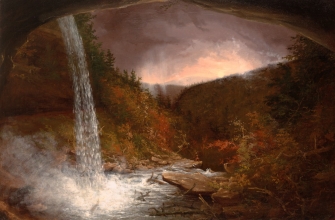
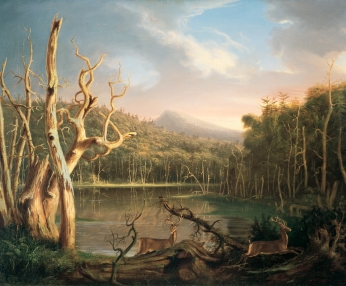
Left to Right: Kaaterskill Falls, 1826 (as owned by Trumbull); Lake with Dead Trees, 1825 (originally owned by Durand)
In a way that seems like a passage from fiction, not only Cole’s career, but the first native American tradition of landscape painting, was launched.
In 1829, another patron, Robert Gilmour Jr. of Baltimore, urged Cole to travel, this time to Europe. Carrying the sketchbooks of American scenery he had accumulated over the course of his travels across Pennsylvania, New England and the Hudson River Valley, Cole embarked on travels to England, France, and Italy that continued through 1832. He would meet Constable and Turner, study works in the Louvre, and observe the very different scenery of Italy. Central to our story is the connection he made with publisher John Howard Hinton.
Hinton was editor of The History and Topography of the United States , one of those enterprises reflecting the fascination with the wonders of North America, published by subscription in London, two volumes, in 1830 and 1831. Volume Two contained seventy-five engraved views of American scenery, taken from paintings commissioned from Cole and ten other artists. Among these is the image of the Catskill Mountain House, destined to appear on dining tables as well as on library shelves (1).
_f395x501_1343066935.jpg)
Cattskill Mountain House, N.Y Engraving after Thomas Cole, 1831. From The History and Topography of the United States, Volume II
Cole’s European travels gave him a more cosmopolitan outlook, resulting in images of old world landscape, sometimes tinged with historical elements or involving elaborate allegorical schemes. Cole, however, heeded the advice offered by his friend, poet William Cullen Bryant on his departure for Europe and kept “that earlier, wilder image bright.” Over the course of his career, he would repeatedly return to the American landscape – eventually purchasing property in Catskill – in that land surveyed in the panoramic view from the Mountain House. He revisited the resort itself as seen in these oils from the later 1840’s.
_f331x273_1343067628.jpg)
_f332x218_1343067688.jpg)
Even today, it is this work, most closely associated with the Hudson River Valley, which draws unalloyed praise from critics and public alike.
William Adams and the "Cattskill Mountain House, U.S." View
For Staffordshire potter William Adams IV, publications like Hinton’s History and Topography represented a goldmine.
The Adams family had been in the pottery business since 1657. Like other Staffordshire potters their product ranged from basic utilitarian ceramics to fashion conscious luxury wares. In the first half of the nineteenth century, when advances in printing technology on earthenware opened seemingly endless new markets for affordable finery, Adams became one of the giants of transferware production.
The fortunate convergence of new technology with cultural trends – namely interest in landscapes and the picturesque – provided the transferware potters with their subject matter. Engravers who settled in Staffordshire – some employed in house by the potteries – could adapt popular prints freely to create scenic patterns. Until the advent of copyright laws, what could be more convenient or economical? The romantic vocabulary of rustic country, shaggy animals, and sometimes shaggy inhabitants, overtook the more classical or Chinese-inspired elements of dinnerwares.
(Brown Transfer Plate, "Gipsy;" Red Transfer Salad Plate, "Park Scenery;" Medium Blue Transfer Dessert Plate, "Fisherman's Hut")
For these savvy potters, America represented a wide-open export market with no competing native ceramic industry. The patriotic patterns of the 1820’s relating to heroes like Lafayette, Washington and Franklin, were followed by patterns picturing North American sites that would appeal to American pride. That brings us to the Adams/Hinton connection. Adams along with Enoch Wood and the Jackson brothers, helped himself freely to the images of “picturesque” American scenery offered in the work.
By the mid 1830’s Adams had created an entire dinner service based on views from Hinton. For both dinner and soup plates, they chose Cole’s view of the Catskill Mountain House – with a bit of minor alteration. Well-dressed female figures in conversation replace Cole’s lone rider, and a pond has appeared in the foreground. Ellouise Baker Larsen lists a dozen known views in the service: all from Hinton, seven by Thomas Cole (2). Each view was framed in Adams’s distinctive floral and shell pendant border. A special eagle cartouche framing the backstamp left no doubt over the intended target market. America was important enough to William Adams for him to make two Atlantic crossings and to establish an office in New York City.
Adams was not the only, or even the first potter to back an American export strategy with services featuring American views. The Ridgways in their “Beauties of America” series bypassed the wilderness to focus on the country’s new structures and institutions, like the Philadelphia Library – signs of a developing urban culture. Enoch Wood hedged his bets with a series that saluted nature in scenes like “Trenton Falls” as well as such man made achievements as the Baltimore and Ohio railway and the White House. Wood also offered his own Catskill Mountain House view based on Cole’s work for Hinton.
(Left to Right: Ridgway "Beauties of America: Philadelphia Library;" Wood "Trenton Falls")
More and more American households could acquire decorative tablewares. Enterprising British potters were eager to fulfill that need. And luckily, subsequent generations valued these heirloom wares enough that a whole stack of “Cattskill Mountain House" dinner plates confronted us in a market that sunny day about one hundred and fifty years later.
.jpg) Conclusion: Where Were You in '62?
Conclusion: Where Were You in '62?
In the summer of 1962, the Brown family carried on the tradition of American tourism with a vacation in Washington D. C. Our itinerary, however, focused on the works of man -- monuments, museums and memorials – rather than natural beauties. We would never have imagined making the trip to New York state to look at Hudson River scenery or the derelict structure which had once been the Catskill Mountain House, reigning like some ghostly queen some twelve miles above the Hudson River .
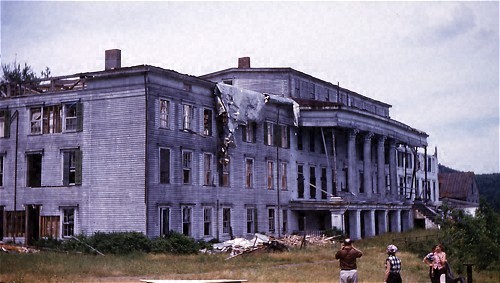
Catskill Mountain House, 1953
The fame of the resort had started to slip after the Civil War as newer resorts appeared and the powerful took their summer sojourns elsewhere. The last season was 1941; after which the structure stood silent, slowly deteriorating through fire, storms – and we are sure – vandals. The state of New York acquired the property in 1962 precipitating a fierce battle between the forces of historic preservation and natural conservation. In the end, the powers of conservation won: forest management followed a zealous policy of clearing structures from land retroactively decreed to be “forever wild.” So it was that on January 25, 1963, the Conservation Department of the State of New York burned the remains of this historic institution to the ground.
It would be very easy for wistfulness to degenerate to bitterness over the end of the Catskill Mountain House. Robert Yasinsac has posted on line a series of haunting photos of the sight -- void of any vestige of the structure -- which leaves one with a sense of regret over that inglorious end (http://www.hudsonvalleyruins.org/yasinsac/catskill/catskill.html) . There is irony too that an early milestone in what would become the conservation movement, founded on an appreciation of the virgin wilderness, would itself be labeled a manmade intrusion and destroyed.
The Catskill Mountain House—remembered today as a highland campground with a phantom set of gateposts, as the unexpectedly classical palace on the mountainside in a raft of Hudson River School paintings, and in a red transferware dinner plate by William Adams.
Mark
Notes and Sources
Notes
(1) Cole’s Views in Hinton: “Timber Raft on Lake Champlain,” “White Mountains, New Hampshire,” “A View Near Conway, N. Hampshire,” “Hartford, Connecticut,” “Monte Video, the Residence of D.Wadsworth, Esqr., Near Hartford, Connecticut,” “ A Distant View of the Falls of Niagara,” “Ruins of Fort Ticonderoga,” “View of the Cattskill Mountain House, N.Y.,” “The Falls of Cattskills,” “Lake George,” “ Head Waters of the Juniata, Alleghany Mountains, Pennsylvania,” “View from Mount Washington.”
(2) Cole Views (in addition to the Catskill Mountain House)-- as used by Adams -- Listed by Larsen: the modest “Monte Video” seven inch plate, the luncheon plate with its “View Near Conway,” ”a soup plate with the “Headwaters of the Juniata” view and multiple platters as well as some serving pieces including the “White Mountains, N. Hampshire,” “Lake George,” and the sublime twenty inch —“Niagara” platter.
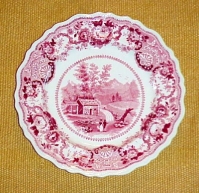
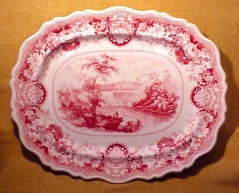
(Left to Right: “View Near Conway” Luncheon Plate; “Niagara” Platter
Books and Exhibition Catalogs
Furniss, David A., Wagner, J. Richard, Wagner, Judith; Adams Ceramics, Staffordshire Potters and Pots, 1779-1998; Schiffer Publishing, Atglen, Pa.; 1999
Larsen, Ellouise Baker; American Historical Views On Staffordshire China; Third Edition; Dover Publications, New York; 1975
Siegel, Nacy; Along The Juniata, Thomas Cole and the Dissemination of American Landscape Imagery; Exhibition by the same name, Juniata College Museum of Art, Huntingdon, Pa; 2003; Published by Juniata College Museum of Art in Association with University of Washington Press, Seattle; 2003
Taylor, Joshua C.; America As Art; Harper & Row, New York, Hagerstown, San Francisco, London; 1976
Truettner, William H. and Wallach, Allan; Thomas Cole, Landscape into History; Exhibition by the same name, National Museum of American Art, Smithsonian Institution, Washington, D.C., 1994; Published by Yale University Press, New Haven and London; 1994
Internet Resources
The Catskill Archive:"The Mountain Ball," 1822; "A Visit to the Mountain House," 1826;" http://www.catskillarchive.com/articles.htm
Photo Credits
Cole Self Portrait; http://www.wikipaintings.org/en/thomas-cole/self-portrait-1836
Other Cole Works;Engraving; Smith Aquatint; http://www.hudsonriverschool.org/trails/1/sites/8/views/75
Mountain House Photo, 1953;http://en.wikipedia.org/wiki/File:Mtn_house_1953.jpg
« Prev
Next »









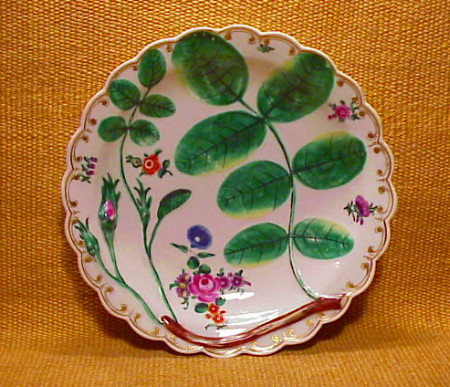
_f224x194_1353265335.jpg)
_f227x192_1353265988.jpg)
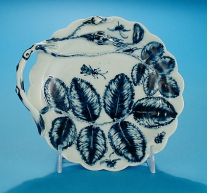
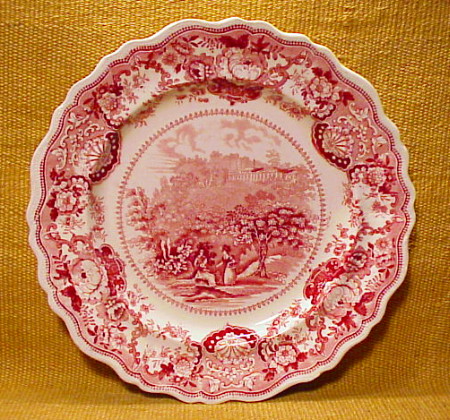
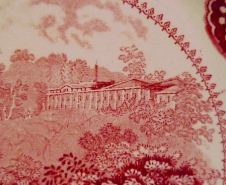
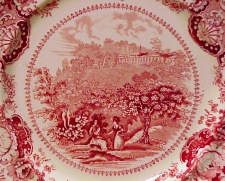
_f222x219_1343159744.jpg)
_f217x217_1343159829.jpg)
_f212x214_1343159877.jpg)
